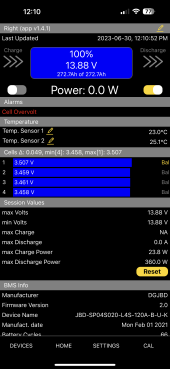Appreciate there are dozens of top balance threads going, but I'm struggling with an issue now for a couple of years and hoping for some guidance. I'm happy to provide my detailed approach but to summarize, I'm using the tried and tested method that most are using; cells in parallel taken to 0 amps. I've just completed my third attempt on a 12V bank and just can't seem to get all cells to the same level. Everything goes well, with the the cells getting to about 3.64V and .30 amps on the power supply. When I put the bank back into series and connect to my charging system, inevitably 1 cell is slightly higher causing the BMS to go into overvoltage protection.
I've ruled out any 1 bad cell because each time I go through the top balance process it's a different cell causing the overvoltage. I've even attempted to top up just those cells that are lagging compared to the others but no luck. I'm looking for some guidance here. Everything is working fine and the overprotection on the BMS is doing it's job but I'd rather not have my last line of defense being used on the daily.
Is there a different approach you would recommend? Is there a smarter way of top balancing, I'm not apposed to buying something to save my sanity!
I've ruled out any 1 bad cell because each time I go through the top balance process it's a different cell causing the overvoltage. I've even attempted to top up just those cells that are lagging compared to the others but no luck. I'm looking for some guidance here. Everything is working fine and the overprotection on the BMS is doing it's job but I'd rather not have my last line of defense being used on the daily.
Is there a different approach you would recommend? Is there a smarter way of top balancing, I'm not apposed to buying something to save my sanity!
Last edited:





